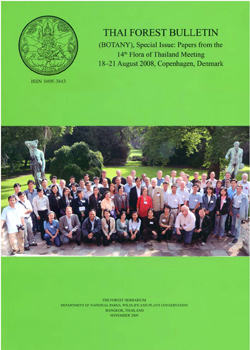Biogeographic links between Thailand and Nepal and the potential for collaboration between their Flora projects
Abstract
The Flora of Nepal Project aims to produce a complete Flora of its 7000 species within 15 years and will shortly publish the fi rst of 10 volumes. Nepal is of particular importance in Asian botany because many widespread Asian plants were fi rst described from specimens collected in Nepal in the early 19th century. Nepal has a huge diversity of habitats due to its enormous altitudinal range, rugged topography and consequent variety in microclimates. With its central position in Asia, Nepal has links to Thailand via the Sino-Himalayan and Indo-Malayan fl oristic regions. These links have been quantifi ed by analysis of the distributions of the species in the 31 families in Volume 7 of the Flora of Thailand. Several families have large overlaps between Thailand and Nepal at both the specifi c and generic level, with clear implications for the production of accounts for the two Floras. Analysis of the occurrence of Nepali species within Thailand shows that they are most abundant in the Northern and North-Eastern regions.Downloads
Download data is not yet available.
Downloads
How to Cite
Pendry, C. A., Parnell, J. A. N., & Van Welzen, P. C. (2014). Biogeographic links between Thailand and Nepal and the potential for collaboration between their Flora projects. Thai Forest Bulletin (Botany), (37), 169–185. retrieved from https://li01.tci-thaijo.org/index.php/ThaiForestBulletin/article/view/24370
Issue
Section
Articles



